Posts by Christopher Lochhead
127 The Electric Vehicle Category: Unpacking The Rivian IPO with Al Ramadan, CoAuthor of Play Bigger
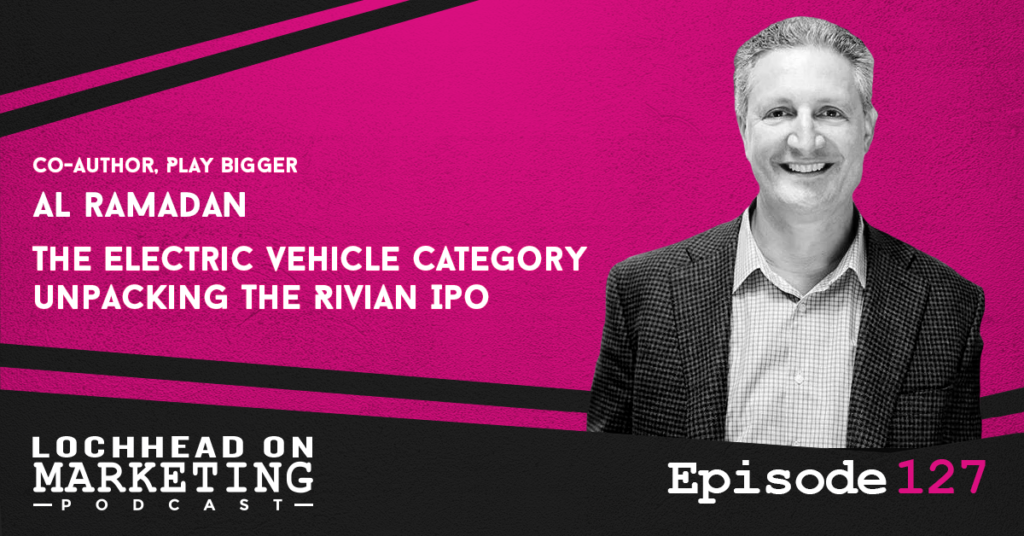
Podcast (lochheadonmarketing): Play in new window | Download (Duration: 50:14 — 34.5MB) | Embed
Subscribe: Apple Podcasts | Spotify | RSS | More
The electric vehicle category is a giant new mega category that is completely changing the transportation landscape. Rivian is a startup who has yet to ship a product, yet somehow is pioneering a differentiated category in EVs. It is also on the verge of what will likely be a massive, multi-billion dollar IPO.
In this episode of Lochhead on Marketing, Al Ramadan and I unpack all of it through the category lens. He has been blogging about this lately, so it seems fitting to invite him and have a conversation about it. If Al’s name sounds familiar, that’s because he and I co-founded Play Bigger Advisors, and coauthored the book, Play Bigger together.
So sit back and enjoy this dialogue between two category design enthusiasts as we share our thoughts on Rivian’s new upcoming massive IPO.
Al Ramadan on Rivian and the Upcoming IPO
Al shares his thoughts on Rivian, and what they are doing for the Electric Vehicle category. He describes its founder as something of a combination of Steve Jobs and Elon Musk, and thinks he is a remarkable entrepreneur.
He then talks about the upcoming IPO they have planned to release around Thanksgiving.
“A couple weeks ago, they announced that they’re going to do this IPO around Thanksgiving. And it’s an IPO, not a spec. All of the other EVs are going out with specs. And the zinger was that the market cap was going to be $80 billion. Bigger than GM, bigger than Ford.
But it was just this moment in time where you look at this thing is like, “what, they haven’t shipped the vehicle”. And they’ve valued more than Toyota’s entire SUV line and Ford or GM, it just doesn’t make (sense). That’s just crazy. And so the category designer in me sort of took over and started dissecting all of their filings and I came up with a few insights that I think is worth sharing. ” – Al Ramadan
The Potential of the Rivian IPO
For something that has not even shipped the product yet, it seems amazing that they are valued so highly. For it to do so well at this point, it must’ve hit all the right notes and laid out its potential to be able to grab the attention of investors and consumers.
“What they miss always, is what the real drivers of market cap are. Which is, number one: what’s the potential for this category? Number two: do we believe that this company can prosecute the magic triangle company; product, company, and category and earn 76% of the economics? And number three: when we look at their numbers, metrics, financials, etc., are we comforted about the first two things? And if the answer to all of those is that you got a company who’s designing a market category, that right now looks like that has the potential of almost infinity.” – Christopher Lochhead
Al agrees with this points, and further explains how this new IPO is changing the vehicle industry, and how the transactions and support will be implemented once it comes out. Up until now, most EVs still operate in the traditional car dealership model. Rivian seeks to create a new category centered not just on the cars, but the services provided with it.
Reactions to the Rivian IPO
One of the things that piqued Al’s interest was how certain people or companies reacted when the valuation for the Rivian IPO went out. One particular instance was Elon Musk tweeting about it, saying that they should at least put out a product before the IPO.
It seemed illogical that someone like him would be alarmed by this, especially if you’re perceived as being the king of a certain category. Yet for a brief moment there, it seems that he has shown concern over the matter, and saw a challenger on the rise.
According to Al, it’s right that he would be concerned. Because if you look at it, Rivian seems to be taking the Electric Vehicle category and evolving it to something that can make their current category obsolete in the future. While the implementation of which remains to be seen, it’s definitely enough to be concerned about.
To hear more from Christopher and Al and their thoughts on the Rivian IPO, download and listen to this episode.
Bio
Al Ramadan is a co-founding partner of Play Bigger Advisors and coauthor of the book, Play Bigger. He also co-founded Quokka Sports, which revolutionized the way people experience sport online.
Al then joined Macromedia and Adobe, where he spent almost ten years changing the way people think about great digital experiences. At Adobe, Al led teams that created the Rich Internet Applications category and helped develop the discipline of experience design.
In the early ‘90s he applied data science to Australia’s Americas Cup — an innovation in sports performance analytics. His work in sailing led directly to the idea for Quokka. He lives in Santa Cruz, California.
We hope you enjoyed this episode of Lochhead on Marketing™! Christopher loves hearing from his listeners. Feel free to email him, connect on Facebook, Twitter, Instagram, and subscribe on Apple Podcast! You may also subscribe to his newsletter, The Difference, for some amazing content.
238 Hear Yourself: How To Find Peace In A Noisy World with Prem Rawat
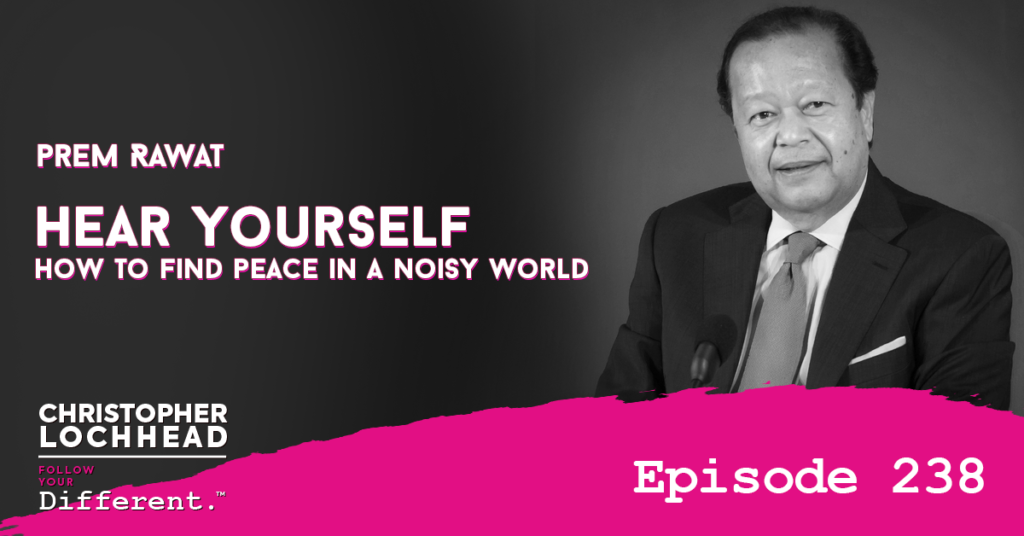
Podcast: Play in new window | Download (Duration: 1:02:06 — 42.6MB) | Embed
Subscribe: Apple Podcasts | Spotify | Pandora | RSS | More
Is peace really possible? Our guest today says it is. In this special episode of Follow Your Different, Prem Rawat talks about how to find peace in a noisy world.
Prem Rawat has been teaching peace since he was a little boy in India. He became a counterculture icon in the 60s and the 70s, as Americans sought out different ideas and beliefs. He’s been a source of great controversy and massive followership over the years. Prem has been sought out and welcomed by spiritual, social and political and business leaders around the world.
Prem Rawat has a new book out, called Hear Yourself: How to Find Peace in a Noisy World. We are here to discuss all that and more, so stay tuned.
Prem Rawat on the Current State of the World
When asked about his current thoughts, Prem talks about the current state of the world. For him, it seems that there’s just too much drama and chaos in the world right now. Though the current situation right now plays a big factor as to why it may be so, people are still whipping it up and causing drama left and right.
While it is the nature of humanity to seek out exciting events and drama, it seems that we have become morbidly so, despite the situation being something as it is right now. Much so that we choose to forgo peace to chase the next drama.
“Well, you know, here’s the paradox, because (when) you look at human beings, human beings are remarkable. We’ve been able to conquer disease, we’ve been able to invent so many wonderful things that that has helped other people. Though at the same time we can create medicine that can that can prolong life, we can also create machine guns that can take away the lives. So we always live in this paradox.
I always feel that we have to choose, and I talk about peace. I feel that we have to choose peace. It’s not just going to happen automatically, that is not going to drop from the sky, on people, whether they like it or not. It’s just that Something that we have to choose. And the question then becomes, is that what we’re choosing?” – Prem Rawat
Choosing Peace
Prem continues on how we should actively choose peace. Because the way we are treating it right now, it’s just something that we expect to happen to us, despite being distracted by everyday noise. If you want peace for yourself, you have to distance yourself from the noise and drama, and choose peace.
“Well, peace is already within you, (but) you have to gain access to it. And that’s what this book is all about: getting in touch with yourself. Because we are so distracted. In fact, being with yourself, in an environment is considered the worst form of punishment you can possibly have. We have become so attracted to everything else that we became distracted from ourselves. That is a pretty sad state of affairs, when it comes to ourselves. That being with you, just being with you, is the worst thing you could ever do.” – Prem Rawat
Can We Really Have Peace?
Prem shares his life of going around the world and speaking to the international crowd about peace. Though he thinks that just doing that was not enough, and that is why he wrote his book. With it, he hopes that it can spark a meaningful conversation or even a debate about peace.
Though there are those who say peace is not possible, that it is in the human nature to seek conflict or drama. For Prem, this is not so, as peace is already within all of us. So for him, these people can be considered sourgraping, in a sense.
“It’s a question of sour grapes. there’s a lot of people say it this way. It’s like, oh no, peace is not possible. It’s not going to happen. But when peace is already inside of us, why isn’t that ever going to happen? And isn’t it up to us? If we can create wars, why can’t we create peace?” – Prem Rawat
To hear more from Prem Rawat and how to find peace in this noisy world, download and listen to this episode.
Bio
Prem Rawat
For more than fifty years, Prem has shared his enduring message with people of any age, race, gender, nationality, religion, personal lifestyle or life condition, that peace within is possible and it is your birthright. He has reached hundreds of millions of people in over 100 countries through his powerful storytelling and profound message.
As a best-selling author and public speaker, he has adapted age-old stories for a modern audience, adding his unique perspective on the “business of life.” These stories continue to resonate and transform millions of people’s lives. His most recent book, Escúchate (Hear Yourself), quickly reached Amazon Spain’s top non-fiction best seller’s list, and precedes the soon-to-be released English version. Other publications by Prem include: Peace is Possible (published by Penguin) previously titled Splitting the Arrow: Understanding the Business of Life, as well as the illustrated books, The Pot With The Hole, and The Stonecutter.
Prem has personally developed an innovative wellbeing series called the Peace Education Program (PEP) that helps anyone interested to discover their inner strength and reflect on their own humanity.
Around the globe, Prem has also shared his practical approach to knowing yourself through a video-based course, Peace Education and Knowledge (PEAK), available free of charge on his media platform, TimelessToday. In these challenging times, Prem’s message, his inspiration and the experience he points to, are more relevant than ever.
The Prem Rawat Foundation, established in 2001, supports charitable activities throughout the world, including Prem’s Peace Education Program, which is now taught in places as diverse as prisons, countries ravaged by war, schools, universities, police academies, veteran centers and in hospitals in over 80 countries across 6 continents. From Cape Town, South Africa to California, from East Timor to Colombia, the Peace Education Program has reached people across wide spectrums of societies and inspires them to discover their innate personal peace.
To further advance his ability to reach people interested in his message, Prem became a pilot, logging more than 14,000 hours of flying time worldwide. He is also a composer, musician, photographer, husband, father of four children and grandfather of four.
Links
Follow Prem Rawat today!
Website: PremRawat.com
Twitter: @PRBookFans1
Youtube: @PremRawatOfficial
Instagram: @timelesstoday
Check out the book: HearYourselfBook.com
We hope you enjoyed this episode of Follow Your Different™! Christopher loves hearing from his listeners. Feel free to email him, connect on Facebook, Twitter, Instagram, and subscribe on iTunes!
126 How To Spot Legendary Startup / New Category Ideas
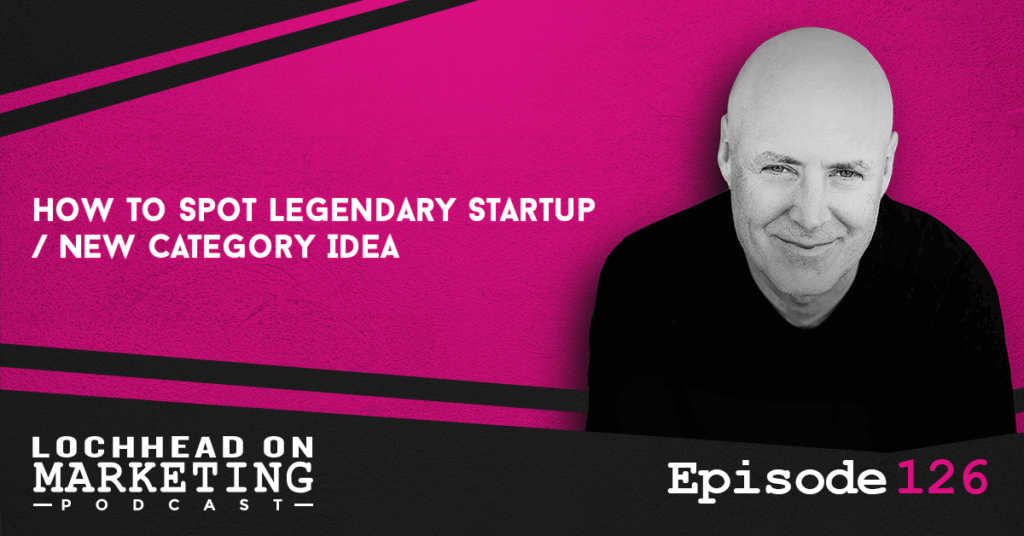
Podcast (lochheadonmarketing): Play in new window | Download (Duration: 18:36 — 12.8MB) | Embed
Subscribe: Apple Podcasts | Spotify | RSS | More
In this episode of Lochhead on Marketing, let’s talk about how to spot a legendary startup / new category idea.
It turns out there are a few secret hiding places where these ideas hide, but they’re in plain sight. One of these ideas was shared by Avram Miller in a recent episode of Follow Your Different (FYD 234) when we were discussing his new book, titled The Flight of a Wild Duck. It is a simple, powerful, yet under-used idea for discovering massive ideas for new companies, products or categories, so we are going to talk about it in detail here. As a bonus, I’ll share one of my own as well!
So stay tuned to this episode, and enjoy.
Avram Miller on Being a Legendary Startup
When we talked to Avram Miller in Follow Your Different, we got into the discussions of why a lot of startups seemed to fail. These startups had, on paper, great ideas for products, services, and categories that should have dominated the market. Yet looking back, most of them did not achieve that potential.
So what was the culprit? It was time. Specifically, they were too early or ahead of their time. Whether it was due to being technologically early or there’s no demand for that particular idea yet, it was just too early.
One of the examples was WebVan.com. It was a startup designed to deliver groceries to your home, and it was launched in the late 1990s. If you think about it nowadays, it makes sense that it would be a successful business. Yet WebVan.com shut its business down in 2001, while the same model today made Amazon a household brand.
So if you have a legendary startup idea, one of the things you need to consider is this: is it too early, or just the right time to launch it to the world?
Never Stop Innovating
Idea no. 2 comes from me, and what I have observed upon past and existing category leaders in their respective markets. As I have discussed here in Lochhead on Marketing, and also at our Category Pirates newsletter, sometimes these Category Kings settle with fighting for a share of the market, rather than innovating and creating new markets for their own.
One of the most known examples of this was Kodak and the physical media category, which tried to adapt too little, and too late. Surprisingly, Avram Miller shares in our conversation that Intel’s CEO Andy Grove was also resistant to innovating things early on in Intel’s history, which almost led them to miss out in getting into the chipset business for personal computers.
As for a great example in the opposite direction, Victoria’s Secret got left in the dust by Rihanna’s line of lingerie called Savage. This was because it moved away from the POV of “be like these supermodels”, to more inclusive and being comfortable with their own body. This radically different POV redesigned the category. As most native digitals see exclusivity as elitist and not welcoming, it was also embraced by the market almost overnight.
So at the end of it all, would you rather be fighting to stay on top of your current market, or be the King of the Hill in a category that you have created or innovated?
To hear more ideas on how to become a legendary startup or innovate your current business, download and listen to this episode.
Bio
Christopher Lochhead is a #1 Apple podcaster and #1 Amazon bestselling co-author of books: Niche Down and Play Bigger.
He has been an advisor to over 50 venture-backed startups; a former three-time Silicon Valley public company CMO and an entrepreneur.
Furthermore, he has been called “one of the best minds in marketing” by The Marketing Journal, a “Human Exclamation Point” by Fast Company, a “quasar” by NBA legend Bill Walton and “off-putting to some” by The Economist.
In addition, he served as a chief marketing officer of software juggernaut Mercury Interactive. Hewlett-Packard acquired the company in 2006, for $4.5 billion.
He also co-founded the marketing consulting firm LOCHHEAD; the founding CMO of Internet consulting firm Scient, and served as head of marketing at the CRM software firm Vantive.
We hope you enjoyed this episode of Lochhead on Marketing™! Christopher loves hearing from his listeners. Feel free to email him, connect on Facebook, Twitter, Instagram, and subscribe on Apple Podcast! You may also subscribe to his newsletter, The Difference, for some amazing content.
237 Creative Acts for Curious People with Stanford Design School Executive Director Sarah Stein Greenberg
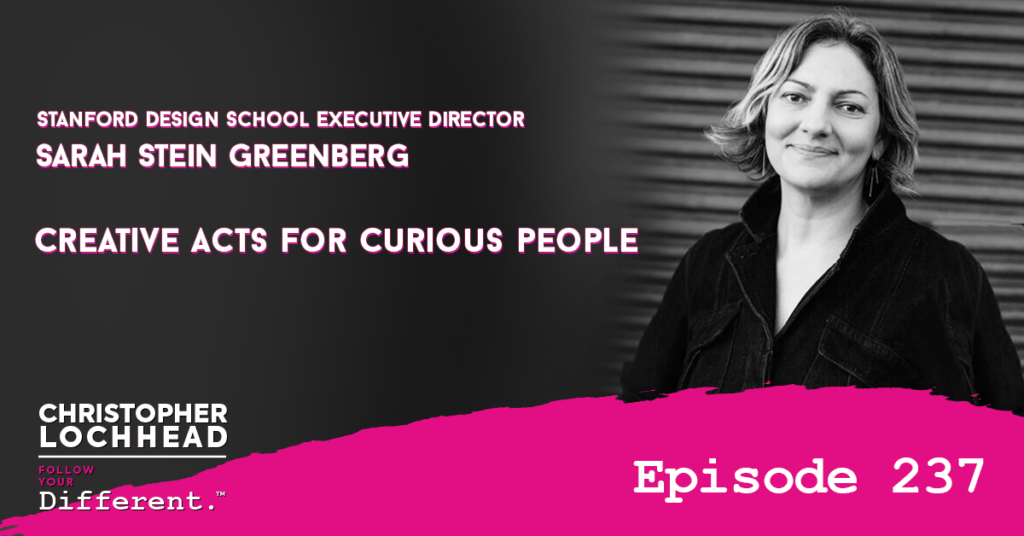
Podcast: Play in new window | Download (Duration: 1:04:45 — 44.5MB) | Embed
Subscribe: Apple Podcasts | Spotify | Pandora | RSS | More
In this episode of Follow Your Different, we talk about all things creativity, innovation, and design. Our guest today is Sarah Stein Greenberg, the Executive Director of Stanford’s Design School, aka the d.school.
She has a new book out called Creative Acts for Curious People: How to Think, Create, and Lead in Unconventional Ways. They have taken years of learning and ideas from Stanford’s Design school and put it in this awesome new book, and we get to dive in to all of it.
Sarah shares why reflections matter so much, and also tells why metacognition is important. We dig into what it’s like running one of the most well-known design schools in the world, and how design students are different today than they were in the not-so-distant past. Also, pay special attention to Sarah’s ideas on weird and the role of curiosity in creativity and design.
Sarah Stein Greenberg on Reflections and Creativity
Sarah talks about finally being back in the physical space of Stanford campus. She describes the space that she has a space for reflection, full of writing space to record her thoughts as they come.
When asked if reflection is really important in design, Sara shares that it plays a part in it. That it is something that should go hand-in-hand with action.
“I think reflection is kind of the underappreciated partner of action. In a lot of cases, when people think about creativity, they think about brainstorming and exuberance, and that that spark of inspiration. But reflection, I think about it as it’s like the peanut butter and jelly sandwich, those two things are, inextricably linked action and reflection. So yeah, I’m a big proponent of those quiet moments, where you’re trying to make sense or really think about what might be the implications of your creative work.” = Sarah Stein Greenberg
What? So What? Now What?
Sarah shares about the difference between thinking and reflection. Thinking might include everything from coming up with new ideas, charting the vision, or even some parts of analysis / research. Reflection focuses more on thinking about your own process or practice, or looking back at your data more critically.
Sarah goes on to say that reflection in particular benefits from specific scaffolding and practices, and brings up one of her favorite one: the What? / So What? / Now What?, which a few of her colleagues have originated.
“The scaffold is called What? So what? Now What? You can kind of have a scaffolded reflection and think about, what did I just learn in that particular class or that particular project? How do I want to improve my own work? But if you use a scaffold like What, So What, and Now What, you really get into the details. You might write down everything that happened, then you might think about what did all of that mean? Why is that important? Why did that feel like what I wanted to capture? And then Now What is the opportunity to think for each of those. So what for each of those implications? What do I want to do about that? Is that something I want to practice? Is that something I want to improve?” = Sarah Stein Greenberg
For Sarah, the quality of reflections changes dramatically if you have a detailed flow on how to approach and assess what you currently have.
Sarah Stein Greenberg on Metacognition
The conversation then steers into how a lot of people nowadays aren’t really thinking, or thinking about thinking. Most content or “new things” in the market are just variations of the same things that we already have, just rebranded or given a new “spin”.
Sarah agrees with this sentiment, and also talks about metacognition, which is the technical term for “thinking about thinking”. For her, it’s a skill that should be embedded in the heart of our education.
“(Metacognition) is one of those kinds of secret skills that I firmly believe should be embedded in the heart of our education. What goes along with that is the idea of learning how you learn, is actually the key to like being able to then continue to be a learner, no matter what environment you’re in. That’s actually where reflection which we just talked about is so important. Because that’s actually how you can start to take control. That kind of self-awareness is part of that practice of learning how to learn.” = Sarah Stein Greenberg
To hear more from Sarah Stein Greenberg and how reflection and metacognition can be helpful in creating new categories, download and listen to this episode.
Bio
Sarah Stein Greenberg helps lead the d.school, an interdisciplinary institute at Stanford that nurtures innovators and spreads design thinking.
As Executive Director, Sarah supports a multidisciplinary learning program of about 25 courses that reach more than 500 Stanford graduate students annually, taught by more than 60 experts from the d.school, Stanford faculty and the Silicon Valley community; she also launches and supports new or newly iterated d.school initiatives, including the fellows program (a creative leadership accelerator), a new version of the K-12 Lab focused on innovators changing education, curriculum experiments like “pop-up classes,” and a new project to help university leaders imagine the future of the on-campus experience at Stanford.
Previously, she worked in the innovation practice of Monitor Group in the US and India and advised multinational companies on developing innovation capabilities. Her background includes developing new products and services in a number of emerging markets in Asia and Africa.
In the classroom Sarah has co-taught the d.school’s foundational Design Thinking Bootcamp, and its legendary course on design for the developing world, Design for Extreme Affordability. This year she helped start a new course that aims to spark students’ appetites for disruptive innovation in addressing poverty in the Bay Area.
Sarah holds an MBA from Stanford University and a BA in History from Oberlin College.
Links
Follow Sarah today!
LinkedIn: in/Sarah-Stein-Greenberg
Check out her new book here: Creative Acts of Curious People
We hope you enjoyed this episode of Follow Your Different™! Christopher loves hearing from his listeners. Feel free to email him, connect on Facebook, Twitter, Instagram, and subscribe on iTunes!
125 How Services Firms Do Legendary Category Design / Category Creation
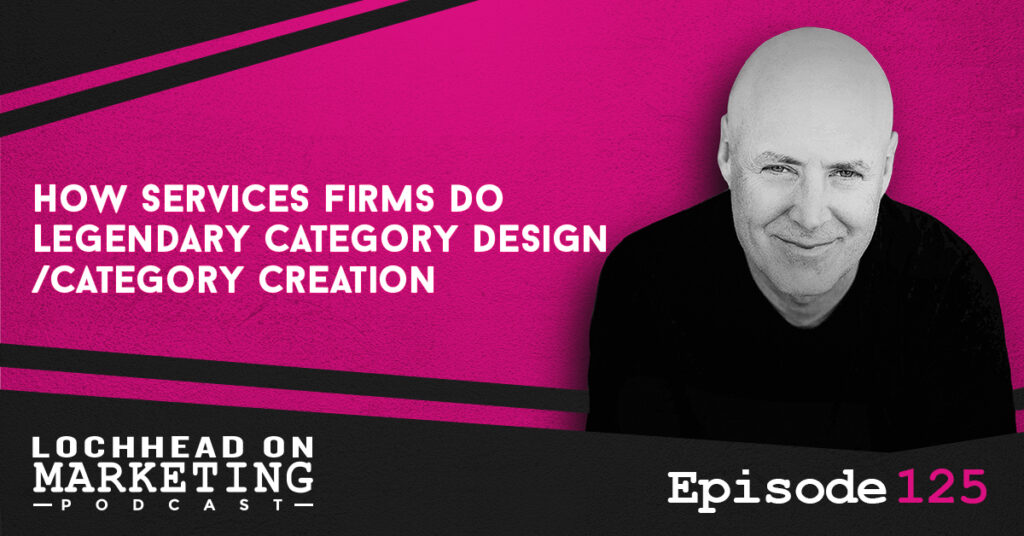
Podcast (lochheadonmarketing): Play in new window | Download (0.0KB) | Embed
Subscribe: Apple Podcasts | Spotify | RSS | More
In this episode of Lochhead on Marketing, let us talk about something that I get asked about all the time. That is, can service firms do Category Design? Simple answer, Yes.
I would even say that the most legendary services companies are almost always created or led by a legendary Category Design.
Long answer? Well, listen to this episode to find out.
The Management Consulting Category Design
There was a point in time where there was no such thing called Management Consulting. Remember, everything is the way that it is because somebody changed the way that it was. So, McKinsey and Company is the firm that created and designed the Management Consulting category.
The interesting thing is the guy that built McKinsey into what it is today is a guy named Marvin Bower. McKinsey started out as a group of bean counters and accountants doing accounting stuff, and nothing like what McKinsey is today.
The Aha moment that Bower had is that he noticed that while clients were paying for accounting services with accountants, and legal services with lawyers, what they often wanted and valued more from their accountant was actually business advice from a trusted source. With that idea, Marvin became the category designer of a new services category called Management Consulting.
Marvin Bower as a Language Master
Marvin is an incredible kind of master at Languaging. He intuitively understood that in order to create a new category of Services Firm, he had to language it differently. That is to say, you can’t talk about a new thing with old language.
Under his leadership, projects were not called jobs, they were called engagements. It’s a word that is much more relational than it is transactional. Internal groups within McKinsey with specific industry or functional expertise were not called groups, they were called practices. Bower borrowed a term from doctors to demonstrate a level of professionalism to elevate these “groups”, or now practices within McKinsey. Finally, he made sure that nobody ever referred to McKinsey as a business: McKinsey was a firm. He highlighted the core values that held the company together.
Today, there are very few firms who are rigorously committed, some might say consciously committed to the original language that Marvin Bower put into place. All of these distinctions, all of these differences, help McKinsey thrive. It also help to position McKinsey in a new category: not a law firm, not an accounting firm, but this new thing called a Management Consulting Firm.
To hear more on how Service Firms do Category Design, download and listen to this episode.
Bio
Christopher Lochhead is a #1 Apple podcaster and #1 Amazon bestselling co-author of books: Niche Down and Play Bigger.
He has been an advisor to over 50 venture-backed startups; a former three-time Silicon Valley public company CMO and an entrepreneur.
Furthermore, he has been called “one of the best minds in marketing” by The Marketing Journal, a “Human Exclamation Point” by Fast Company, a “quasar” by NBA legend Bill Walton and “off-putting to some” by The Economist.
In addition, he served as a chief marketing officer of software juggernaut Mercury Interactive. Hewlett-Packard acquired the company in 2006, for $4.5 billion.
He also co-founded the marketing consulting firm LOCHHEAD; the founding CMO of Internet consulting firm Scient, and served as head of marketing at the CRM software firm Vantive.
We hope you enjoyed this episode of Lochhead on Marketing™! Christopher loves hearing from his listeners. Feel free to email him, connect on Facebook, Twitter, Instagram, and subscribe on Apple Podcast! You may also subscribe to his newsletter, The Difference, for some amazing content.
236 “My Family Is Trapped In Afghanistan” An Entrepreneur’s Story with Noorullah Akbari, Founder of Rosalyn AI
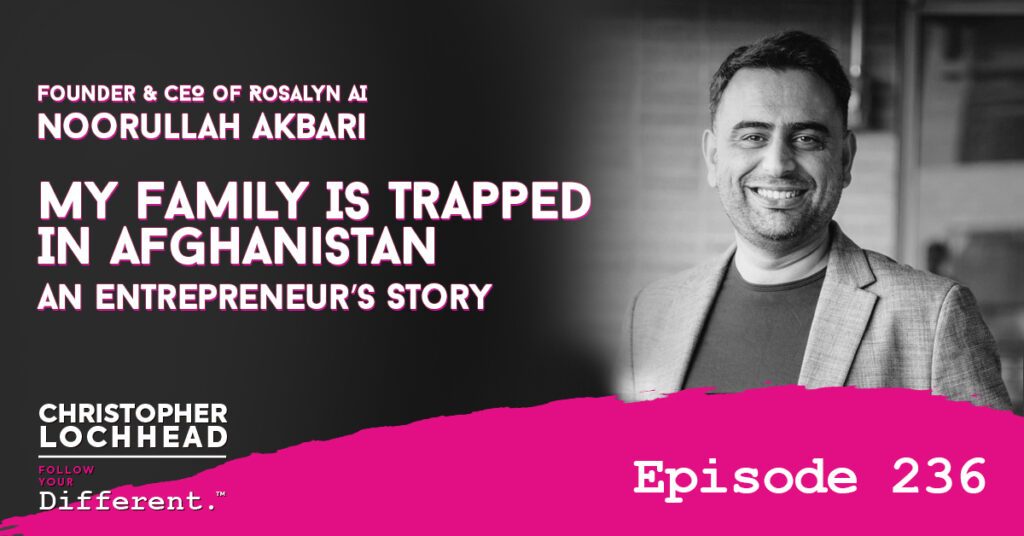
Podcast: Play in new window | Download (Duration: 1:35:18 — 65.4MB) | Embed
Subscribe: Apple Podcasts | Spotify | Pandora | RSS | More
Imagine the life you love, the freedoms you enjoy, and the opportunities you have. All the safety and security you take for granted, vaporized in a matter of days. Imagine that many in your family, friends, and loved ones are now hostages. Noorullah Akbari doesn’t have to imagine any of that.
In this episode of Follow Your Different, Noorullah Akbari talks about the situation of his family and millions of Afghan citizens that are still living in Kabul at this time. Noor is the founder and CEO of a company called Rosalyn.AI, and they are on a mission to use advanced technology in making a difference for students’ education. He’s also a former Afghan refugee living in the United States of America. Right now as we speak, Noor is fighting to get about 20 members of his family out of Kabul, Afghanistan.
Our hope is that this dialogue will help humanize the plight of the very real people in Afghanistan who are suffering right now who want out, and that this very real dialogue will be shared, emailed, tweeted and posted broadly in the United States. Because no matter what you think about the US’ withdrawal in Afghanistan, there are now 35 million people who are experiencing the most horrifying change imaginable in their lives through no fault of their own.
Noorullah Akbari on the Taliban
We start the conversation by asking about the situation with Noor’s family. He shares that his sisters and their family, as well as some of his relatives are still in Kabul. They are quite afraid, and thought that there would be a massacre once the Taliban solidifies their hold.
While the Taliban has said that they will not do such a thing, the family do not trust their word. According to Noor, they think that the Taliban hasn’t done so because they do not want any negative perception at this time. As we live in a technological age, phones and the internet are everywhere. A simple picture depicting their violence could derail the “good image” they want to portray.
Though technology might be keeping the Taliban in check for now, there are limits to what it can do.
“When there are no cameras, they go after those who they believe have aided the infidels and foreigners. They (The Taliban) tell them now, they don’t do that currently in Kabul. And the main reason is, there are cell phones out there. They haven’t banned the internet yet, so that people can take pictures. That will cause them trouble with the international community. But the practice has always been to come after their enemies, kill them and take revenge. So no, you can’t trust the terrorists.” – Noorullah Akbari
Life on the Ground
Noor explains that while he wants to get all their relatives out of Kabul as soon as possible, there are some who are in immediate danger due to their previous involvement with the US forces.
Though he also stresses that most of the people in Kabul have worked directly or indirectly with the US at various times. So it wouldn’t be an exaggeration to think that all of those people will also be considered as enemies by the Taliban.
Yet some might be looking for a way out, simply because they do not want to live under another Taliban regime.
“I can tell you, they have all lived a life under the previous regime of Taliban. When you were going to watch soccer, right after there were public executions, or stoning of people, or beating of women. Women did not have the ability to walk around without men or without the Burqa. It was pretty brutal. You didn’t have any personal freedom, the economy was bad. People were walking around like zombies. And everybody remembers that.” – Noorullah Akbari
So when the US forces drove out the Taliban from Kabul 20 years ago, it was like a new lease of life was given to the citizens living there. To have that freedom taken away now, it’s understandable why people do not want to experience it all over again.
Getting Out of Kabul
When asked about the progress on getting his family out, Noor mentions that he has reached out to his connections to see if they could help, but so far they haven’t been successful. He thinks that either the State Department is currently overwhelmed, or that they are still in the midst of negotiations.
While Noor and others are still exploring other options to get the family out of Kabul, all of their current plans are dependent on how the US can negotiate with the Taliban. This is the most worrying part for Noor.
“All of our efforts are dependent on the negotiation between the US government and the Taliban, to see if they allow these planes to take off right now. From what I know, that’s a difficult thing to do. So they’re trying, but I don’t think the US has footprint there. So when you don’t have footprint and you don’t have leverage, you cannot rely on the Taliban’s mercy to tell you whether you can or can’t fly away.” – Noorullah Akbari
Now imagine that situation playing out with 4 million or so people in Kabul, who also have varying degrees of connection in the US. Yet they’re also grounded in Kabul, with nowhere to go…
To hear more from Noorullah Akbari and how the situation is developing in Kabul at this moment, download and listen to this podcast.
Bio
Noorullah Akbari, Founder & CEO of Rosalyn AI
A three-time entrepreneur, Noor knows how access to technology can transform one’s life. Growing up poor in civil war era Afghanistan, the catalyst for his own transformation was the gift of a computer. That first computer led Noor to found Afghanistan’s first digital printing shop.
A year later, Noor sold the company to a government-backed enterprise to mark his first successful exit. Following stints as a translator and political advisor for the US military in Afghanistan, Noor emigrated to the United States and founded a language testing company.
The idea for Rosalyn’s scalable remote proctoring solution came from the challenge of assessing the language skills in far flung and sometimes hostile environments.
He partnered with machine learning expert Martin Jakobson to design the system and soon realized the value it could bring to the larger global assessment market.
Links
Website: Rosalyn.AI
LinkedIn: in/Noor-Akbari
Please consider supporting these Nonprofits who are helping with the situation in Afghanistan:
We hope you enjoyed this episode of Follow Your Different™! Christopher loves hearing from his listeners. Feel free to email him, connect on Facebook, Twitter, Instagram, and subscribe on iTunes!
235 Moby’s Different Life, Extreme Ways, and New Little Pine Cookbook
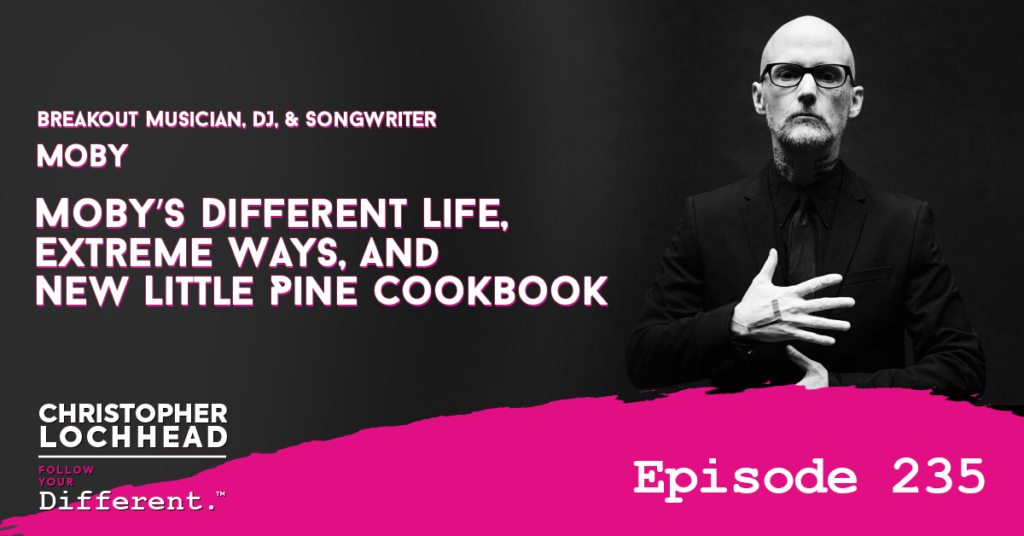
Podcast: Play in new window | Download (Duration: 1:06:40 — 45.8MB) | Embed
Subscribe: Apple Podcasts | Spotify | Pandora | RSS | More
If you’re a long-time listener, you know that we do not have many celebrities as guests on Follow Your Different. We take a pass on most of them because frankly, they’re not that interesting. However, Moby is not your typical celebrity or Hollywood type.
Moby is a breakout musician, DJ, and songwriter. He’s sold over 20 million records worldwide, and he is credited with helping to bring electronic dance music to a mainstream global audience. He is also an animal advocate and a deeply-committed vegan, and he’s got a brand-new cookbook out. It’s called Little Pine Cookbook, which is based on the recipes of Little Pine, a restaurant that he had founded.
What you’re about to hear is a real dialogue like none other: from Moby’s tough start in life, to making and breaking it and having it all fall apart, then building yourself back again. You’ll also hear stories on Moby meeting his heroes, including what it was like to hang out with none other than David Bowie.
Moby on Meeting Your Heroes
To Moby, making the cover for David Bowie’s ‘Heroes’ has a personal context. He shares that when he was around 12, he had bought two David Bowie albums. Since then, David Bowie became his favorite musician of all time.
Then in the late 90’s, they became friends. Then neighbors. They even went on tours together, worked on music together, and enjoyed each other’s company.
“We had this one amazing day where he was in my apartment in New York. We played an acoustic version of heroes together. It was such a magical moment that the version of Heroes on Reprise is sort of a tribute to the song; a tribute to the fact that I was friends with my favorite musician of all time, and a tribute to this moment of playing Heroes with the greatest musician of all time.” – Moby
That said, there is a saying that goes, “you should never meet your heroes, because they are sure to disappoint you.” Moby acknowledges that there are times that it is true. Though in David Bowie’s case, it only made him appreciate the person and his music more after meeting him.
Moby on Being a Public Figure
It’s not unusual to look up to icons and dream of one day becoming one. Being famous or a public figure is a dream that a lot of people have. Though according to Moby, being a public figure can be more stressful than it’s worth.
It might sound pretentious or narcissistic coming from a place of having achieved it already, but it is something Moby wishes to share through his book, ‘Then It Fell Apart’. His documentary, Moby Doc, also shines a bit of light into this:
“The idea is that the human condition is one of confusion. You know, as long as we’re human, we’re baffled. So It seems like we all gravitate towards things that give us a sense of meaning, structure, and status. And so the book ‘Then It Fell Apart’ and ‘Moby Doc’ is sort of looking at that. Like how I had my own individual experience of bafflement, and how I tried to find anything that would give me that sense of meaning, purpose, status, comfort, what have you.” – Moby
Living the Rockstar Life
When asked whether he thinks that he’s “living the rockstar life”, Moby thinks that he has lived a life so far that has given him a unique perspective. As someone who has been to the extreme ends of both poverty, wealth, and varying degrees of fame, it has given him an insight that is undenyingly his own.
Yet while the specific details are unique to him alone, the general circumstance is not. That is why Moby felt that he had to share his story. Not so much as to show everyone what he has achieved in his life so far, but as a reference for those who are aspiring for such a lifestyle, or those who might be in a similar situation.
To hear more from Moby and his insights on meeting your heroes and living an accomplished life, download and listen to this episode.
Bio
Richard Melville Hall, known professionally as Moby, is an American musician, songwriter, singer, producer, and animal rights activist. He has sold 20 million records worldwide. AllMusic considers him to be “among the most important dance music figures of the early 1990s, helping bring dance music to a mainstream audience both in the United States and the United Kingdom”.
In addition to his music career, Moby is known for his veganism and support for animal rights and humanitarian aid. He was the owner of TeaNY, a vegan cafe in Manhattan, and Little Pine, a vegan restaurant in Los Angeles, and organized the vegan music and food festival Circle V. He is the author of four books, including a collection of his photography and two memoirs: Porcelain: A Memoir (2016) and Then It Fell Apart (2019).
Links
Follow Moby today!
Website: Moby.com
Instagram: @Moby
Check out Moby’s books:
Listen to Moby’s Latest Album, Reprise
More on Moby:
VegNews: Moby Just Wrote A Vegan Cookbook, And All Proceeds Go To Animal Rescue
We hope you enjoyed this episode of Follow Your Different™! Christopher loves hearing from his listeners. Feel free to email him, connect on Facebook, Twitter, Instagram, and subscribe on iTunes!
124 The Big Brand Lie: How Categories Make Brands & Why Brand Marketers Never Believe It
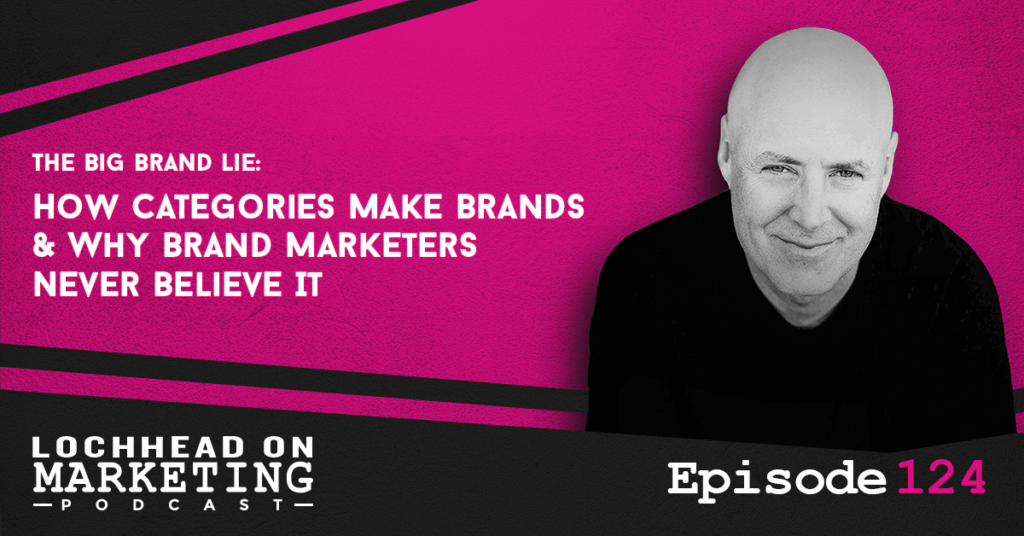
Podcast (lochheadonmarketing): Play in new window | Download (Duration: 46:22 — 31.8MB) | Embed
Subscribe: Apple Podcasts | Spotify | RSS | More
Welcome to a very special episode of Lochhead on Marketing. This episode is based on a recent Category Pirates newsletter that we wrote, which was about Big Brand Marketing and why it doesn’t work.
It is also available as a mini eBook here.
Think of this episode as more of an audiobook than a podcast, as I will be reading the article for you. Without further ado, let’s get to reading.
The Brand Cult
A meaningful percentage of marketers, entrepreneurs, and executives are in what we like to call “The Brand Cult.” They’ve been taught the best (aka: “the most well known”) brand wins.
Even though the data shows this is not true.
- Ford spends $2.5 billion per year on brand advertising, with a market cap of $50 billion. General Motors spends $3 billion, with a market cap of $70 billion. Meanwhile, Tesla spends $0, but has a market cap of $700 billion.
- In 2011, Google spent almost $600 million building and launching a social network to compete with Facebook and Twitter called Google+. If “the best brand wins,” how come Google+ failed? After all, Forbes named Google the 2nd “most valuable brand in the world” in 2020.
- Comcast spends more than $5 billion on branding and advertising each year. And yet, Comcast has long been considered “America’s Most Hated Company.” There’s even a Wikipedia page dedicated to the company’s inadequacies, titled “Criticism of Comcast.” (United Airlines is a close second, if you ask us.) So if branding and “shouting from the rooftops” is the key to winning the game, how come $5 billion per year can’t solve Comcast’s problems? Maybe they need $10 billion?
Though sharing data with a cult member is about the worst thing you can do. That’s because facts are upsetting to feelings—particularly facts that disprove everything you’ve been taught to believe.
Well, here’s a fact:
Categories make brands. Not the other way around.
How The Brand Cult Began
In 2011, The Atlantic published a piece titled, “How Brands Were Born: A Brief History of Modern Marketing.”
“In the 1950s, consumer packaged goods companies like Procter and Gamble, General Foods and Unilever developed the discipline of brand management, or marketing as we know it today, when they noticed the quality levels of products being offered by competitors around them improve. A brand manager would be responsible for giving a product an identity that distinguished it from nearly indistinguishable competitors.”
Note that last sentence.
From our perspective, the obvious response and clear “no brainer” solution to being “nearly indistinguishable” is to get different: design a new space, come up with something new, and make others play a game you created.
But that’s not what most “marketing & branding experts” decided.
Instead, they said, “Let’s ignore the fact there is nothing unique about us, our product, or what we do for the world. Instead, let’s do some branding.” As if sprinkling some kind of magic dust on your “brand” (changing the colors, the font, the logo design, etc.) is going to drive a breakthrough in growth. Or, even worse, “Let’s call ourselves a community. Let’s use big, all-encompassing, undifferentiated language to make ourselves appeal to everyone. Something like, ‘We are an authentic, purpose-driven brand.’”
Thus, “the brand cult” was formed—and The Big Brand Lie began.
If you’d like to hear the rest of the article, download and listen to this episode. You can also check it out at Category Pirates. Who knows, you might find that you have a little pirate in you as well. ?☠️
Bio
Christopher Lochhead is a #1 Apple podcaster and #1 Amazon bestselling co-author of books: Niche Down and Play Bigger.
He has been an advisor to over 50 venture-backed startups; a former three-time Silicon Valley public company CMO and an entrepreneur.
Furthermore, he has been called “one of the best minds in marketing” by The Marketing Journal, a “Human Exclamation Point” by Fast Company, a “quasar” by NBA legend Bill Walton and “off-putting to some” by The Economist.
In addition, he served as a chief marketing officer of software juggernaut Mercury Interactive. Hewlett-Packard acquired the company in 2006, for $4.5 billion.
He also co-founded the marketing consulting firm LOCHHEAD; the founding CMO of Internet consulting firm Scient, and served as head of marketing at the CRM software firm Vantive.
We hope you enjoyed this episode of Lochhead on Marketing™! Christopher loves hearing from his listeners. Feel free to email him, connect on Facebook, Twitter, Instagram, and subscribe on Apple Podcast! You may also subscribe to his newsletter, The Difference, for some amazing content.
234 How Misfits Succeed with Tech Legend, Co-Founder of Intel Capital Avram Miller, Author of “Flight of The Wild Duck”
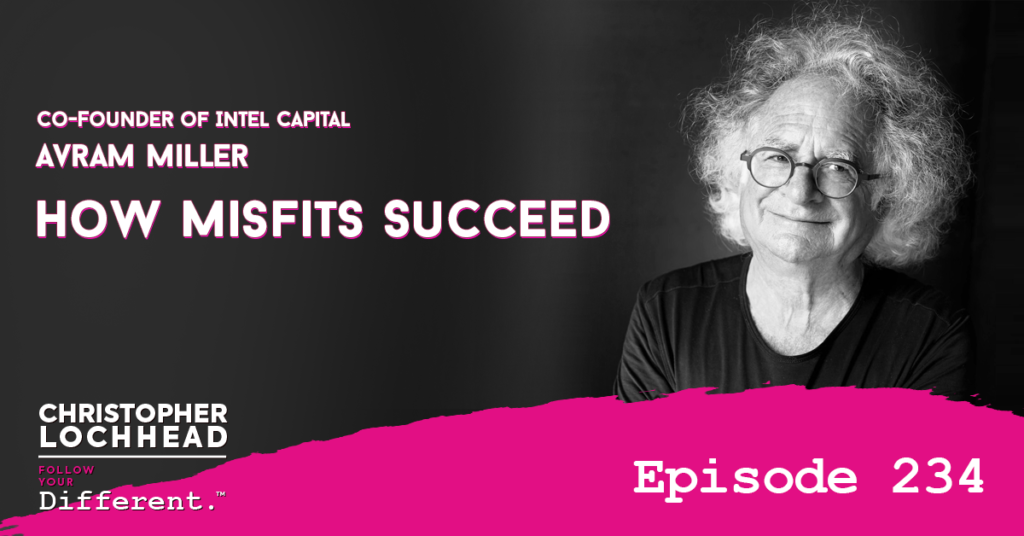
Podcast: Play in new window | Download (Duration: 1:34:07 — 64.6MB) | Embed
Subscribe: Apple Podcasts | Spotify | Pandora | RSS | More
A few companies have had the impact in the technology industry that Intel has had. Without Intel, the personal computer might never have happened the way that it did. In this episode of Follow Your Different, we go inside Intel, and inside the life of one of the tech industry’s true living legends, Avram Miller.
Avram Miller is best known as the co-founder of Intel Capital, the most successful corporate venture group in the history of the technology industry. What Avram and his partners created became the model for corporate venture capital in Silicon Valley. In addition, he’s also famous for spotting and leading Intel’s initiative to create and expand residential broadband internet access.
He’s got a new book out, called Flight of the Wild Duck, and improbably journey through life and technology. So for those who call the Internet your home, stay tuned and have a deep, meaningful, and unedited real dialogue with a true legend.
Avram Miller on Being a ‘Misfit’
When asked about the term ‘misfit’ and what it means for him, Avram shares that for him, it was somebody who wasn’t really right for the system. Though it’s not like that somebody has a problem or is not doing anything, but more of that they couldn’t do what was expected of them.
Which was not to say that he himself was a misfit growing up. Rather, that was how he thought others perceived him. This left him confused and eventually getting the impression that there might be something wrong with him.
Nowadays, he doesn’t get the feeling of being a misfit anymore, though there’s still the notion of feeling like the odd man out.
“I think I still feel like the odd man out. Often, and not so much because of my life today. If I were to be back in my previous life, I would guess I would still feel like I didn’t quite fit in. You know, I was at Intel for 15 years, I achieved a fairly high position at Intel one of the when I was there. And that’s actually kind of what caused me to use the title of my book, which was the Flight of a Wild Duck, which is what Andy Grove, he referred to me as that. But you know, the, the Wild Duck is the duck does not going in the same direction as the other ducks.” – Avram Miller
Life at Intel
Despite all this, Avram did not have any problems working for Intel, and the feeling was mutual. That’s because he has something to give to the company that they needed. So while he doesn’t think he fits in completely, he still had a lot to offer on the table, and Intel valued him for it.
“At Intel, things really based on results. And I had results, I could make things happen. So once I could show that I could make results, once I could achieve things, everything was pretty much okay, because I was judged on my contributions.” – Avram Miller
The Strengths and Weaknesses of Fitting In
That said, he thinks that while these systems are great for finding people that fit, there can also be drawbacks to it. While you can get people that might fit in to your idea of a perfect system, you might miss out on those ‘misfits’ that end up changing the landscape of business.
“Most people go through life, and they go through some system, which was devised in the industrial age. You should think of that process is a funnel that’s filtering out people, it’s filtering out misfits. And at the end, you have people that are really, really good at doing certain things, and no good at doing other things. But those other things are needed. And it’s a strength, because you have all these people that are very, very good at doing certain things, like showing up on time. But it’s a weakness, because they don’t have the creativity, the imagination, the intuition, all this has been filtered out. Either they’ve suppressed it, or the people that had it just didn’t make it through the funnel.” – Avram Miller
To learn more about Avram Miller and his thoughts on how misfits can succeed in the tech world, download and listen to this episode.
Bio
Avram Miller is an American – born businessperson, venture capitalist, scientist, technologist, and musician.
He is best known for his work at Intel, where he served as vice president, co-founded Intel Capital, and led Intel’s successful initiative to create residential broadband.
After leaving Intel, Miller founded the Avram Miller Company, providing strategic advice to technology companies worldwide.
He currently splits his time between Israel and the United States.
He is the author of The Flight of a Wild Duck, an improbable journey through life and technology
Links
Follow Avram today!
Websites:
Twitter: @AvramMiller
LinkedIn: in/Avram
We hope you enjoyed this episode of Follow Your Different™! Christopher loves hearing from his listeners. Feel free to email him, connect on Facebook, Twitter, Instagram, and subscribe on iTunes!

